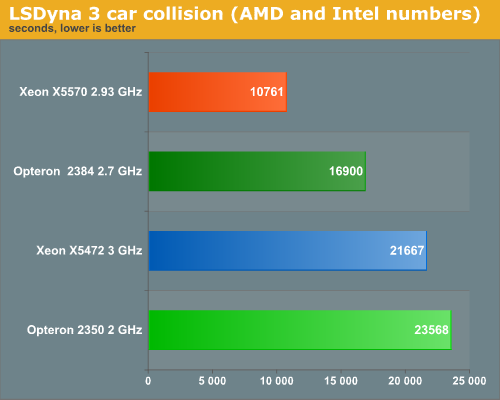The Best Server CPUs part 2: the Intel "Nehalem" Xeon X5570
by Johan De Gelas on March 30, 2009 3:00 PM EST- Posted in
- IT Computing
HPC Market
Contrary to virtualization, web servers, and databases, we have little expertise in our lab to perform and fully understand HPC benchmarks. Nevertheless, we can get an impression from AMD's and Intel's own benchmarking. There are two kinds of HPC applications: those that are completely CPU processing limited (dense matrices) and those that are mostly bandwidth limited (sparse matrices). A good example of the first type is LINPACK. We still have to verify our testing but the first results show about a 15% advantage for Intel. The intensity of the LINPACK benchmark does not allow turbo mode to kick in. LINPACK shows that when it comes to raw FPU performance, the newest Intel is only a few percent faster clock for clock than its competitor.
The second type of HPC applications is far more common. We have found a few LSDyna (crash simulation) numbers.

The Xeon X5570 business applications were fantastic, and the HPC applications are no exception. The newest Xeon is no less than 101% (!) faster than the previous generation of Xeons and almost 60% faster than the best Opteron.










44 Comments
View All Comments
gwolfman - Tuesday, March 31, 2009 - link
Why was this article pulled yesterday after it first posted?JohanAnandtech - Tuesday, March 31, 2009 - link
Because the NDA date was noon in the pacific zone and not CET. We were slightly too early...yasbane - Tuesday, March 31, 2009 - link
Hi Johan,Any chance of some more comprehensive Linux benchmarks? Haven't seen any on IT Anandtech for a while.
cheers
JohanAnandtech - Tuesday, March 31, 2009 - link
Yes, we are working on that. Our first Oracle testing is finished on the AMD's platform, but still working on the rest.Mind you, all our articles so far have included Linux benchmarking. All mysql testing for example, Stream, Specjbb and Linpack.
Exar3342 - Monday, March 30, 2009 - link
Thanks for the extremely informative and interesting review Johan. I am definitely looking forward to more server reviews; are the 4-way CPUs out later this year? That will be interesting as well.Exar3342 - Monday, March 30, 2009 - link
Forgot to mention that I was suprised HT has such an impact that it did in some of the benches. It made some huge differences in certain applications, and slightly hindered it in others. Overall, I can see why Intel wanted to bring back SMT for the Nehalem architecture.duploxxx - Monday, March 30, 2009 - link
awesome performance, but would like to see how the intel 5510-20-30 fare against the amd 2378-80-82 after all that is the same price range.It was the same with woodcrest and conroe launch, everybody saw huge performance lead but then only bought the very slow versions.... then the question is what is still the best value performance/price/power.
Istanbul better come faster for amd, how it looks now with decent 45nm power consumption it will be able to bring some battle to high-end 55xx versions.
eryco - Tuesday, April 14, 2009 - link
Very informative article... I would also be interested in seeing how any of the midrange 5520/30 Xeons compare to the 2382/84 Opterons. Especially now that some vendors are giving discounts on the AMD-based servers, the premium for a server with X5550/60/70s is even bigger. It would be interesting to see how the performance scales for the Nehalem Xeons, and how it compares to Shanghai Opterons in the same price range. We're looking to acquire some new servers and we can afford 2P systems with 2384s, but on the Intel side we can only go as far as E5530s. Unfortunately there's no performance data for Xeons in the midrange anywhere online so we can make a comparison.haplo602 - Monday, March 30, 2009 - link
I only skimmed the graphs, but how about some consistency ? some of the graphs feature only dual core opterons, some have a mix of dual and quad core ... pricing chart also features only dual core opterons ...looking just at the graphs, I cannot make any conclusion ...
TA152H - Monday, March 30, 2009 - link
Part of the problem with the 54xx CPUs is not the CPUs themselves, but the FB-DIMMS. Part of the big improvement for the Nehalem in the server world is because Intel sodomized their 54xx platform, for reasons that escape most people, with the FB-DIMMs. But, it's really not mentioned except with regards to power. If the IMC (which is not an AMD innovation by the way, it's been done many times before they did it, even on the x86 by NexGen, a company they later bought) is so important, then surely the FB-DIMMs are. They both are related to the same issue - memory latency.It's not really important though, since that's what you'd get if you bought the Intel 54xx; it's more of an academic complaint. But, I'd like to see the Nehalem tested with dual channel memory, which is a real issue. The reason being, it has lower latency while only using two channels, and for some benchmarks, certainly not all or even the majority, you might see better performance by using two (or maybe it never happens). If you're running a specific application that runs better using dual channel, it would be good to know.
Overall, though, a very good article. The first thing I mention is a nitpick, the second may not even matter if three channel performance is always better.